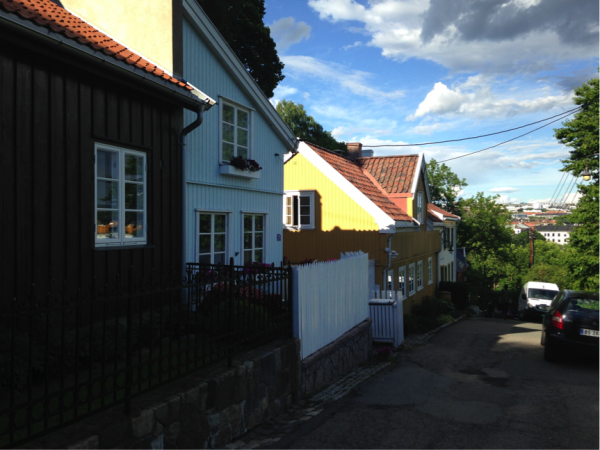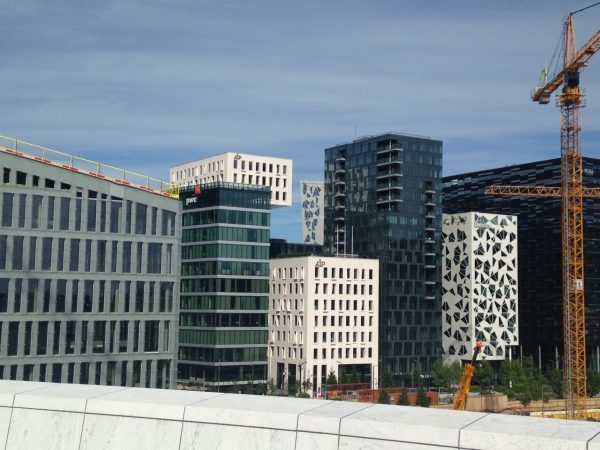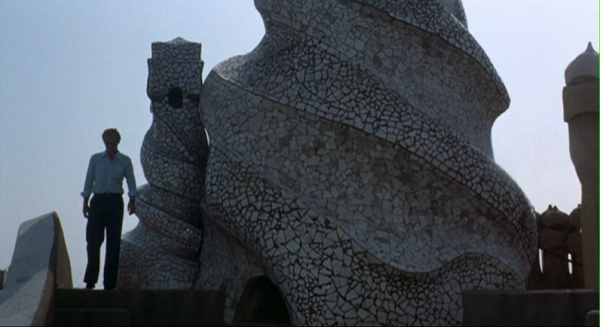By Susan Yelavich

Oslo side street. Photo: Susan Yelavich
Oslo looks to be a very different kind of city, even for a reasonably well-traveled New Yorker. It seems largely residential populated by six to eight-story buildings (many in a restrained, neoclassical style others in Scandinavian cottage form) in pinks, blues, yellows, reds, and white, framed with trees and parks of the deepest green.

Construction around the harbor in Oslo. Photos: Susan Yelavich
Yes, there is all the new construction on the harbor, which speaks to a more rapacious Norwegian prosperity. But otherwise filthy lucre is hardly in evidence. You don’t see it in people’s dress, which tends toward practical sport-driven garb. There is almost no aggressive advertising outdoors and little in the way of attention-getting shop displays. All in all, a feeling of self-effacement dominates, which makes for an odd kind of assertiveness.
Equally, the NORDES 2107 conference was marked by calls for modesty. They were evident in almost all of the keynote speeches. Yoko Akama spoke of “philosophies of absence [that] take non-being or nothingness as the necessary grounds for being” as relevant to truly conscientious design. Even Westfang took exception to ‘design exceptionalism.’ Thomas Binder embraced the idea of design’s ‘weakness.’ All this at a conference of designers dedicated to participatory design, co-design, and social change. (Even in the workshop I co-led with Nik Baerton, Virginia Tassinari, and Elisa Bertolotti, participants cited their solitary acts of writing as the most satisfying part of the collective storytelling process.)

However, none of this amounted to calls to return to the Post Modern 1980s when architecture and design withdrew from the social sphere after modernism’s failure to ‘change to world.’ It was rather a recognition that the ambition to ‘change the world’ is ridiculously hubristic if seen as a project of design alone. Well-intentioned design efforts to care for refugees or house the homeless can be tacitly complicit with the political conditions that make them possible. Mahmoud Keshavarz and Jocelyn Bailey, respectively, made the case that designers are often put in the untenable position of perpetuating greater political systems of injustice in their efforts to help. For example, in providing shelters for those the state refuses to care for, designers risk confirming the state’s estimation that these are people unworthy of the resources we ourselves take for granted. In that view, refugee housing could be considered second-class shelters for second-class citizens.
Notably, though, there was a scarcity of propositions as to how to contend with design’s relative powerlessness in this difficult present when democracy and other forms of political agency are under threat. If retreat isn’t ethically tenable, then what is? Here Evan Westfang (whose own work has to do with making public data both public and visceral) offered an interesting response. He called for a return to ‘normative design’ – not design-for-design’s sake, the stuff of international design fairs and the like. The ‘norm’ of design that he referred to is it’s inherent generosity.

Oslo Opera House, Snøhetta, Wikipedia.
That said, I’m not sure he or anyone else in Oslo would find that generosity where I did during my brief visit, given how skeptical we’ve become of design that is anointed ‘successful.’ I’m referring to my experience of Snøhetta’s Oslo Opera House (2008), which yielded so many unexpected epiphanies—epiphanies, which I suspect are not mine alone. Walking up, on, across, and down its sloping planes, you are never quite sure whether your feet are on the ground or in the air.

Oslo Opera House roof, Snøhetta, Photo: Susan Yelavich
Childhood and adult sensations were felt more than remembered. For me, at least, there was a palpable sensation of the risk that comes from playing in and on a space that seems illicit, namely, the roof. There was the pleasurable disorientation of losing any sense of scale while walking on a glaring white landscape akin to a desert; and the mysterious possibilities of hide and seek around its volumes that Michelangelo Antonioni captured on the roof of Antonio Gaudi’s Casa Mila (1912) in his 1975 film “The Passenger.”

Jack Nicholson on the roof of Gaudi’s Casa Mila. Still image from the 1975 film “The Passenger.”
My conscience pricks me as I write this paean to the pleasures of feeling, to paraphrase Philip Johnson, my ‘molecules being rearranged’ by architecture. Yet, is this so selfish? The philosopher Jacques Rancière argues otherwise. He places value on “the possibility of being together and apart” because space for solitude has become “a dimension of social life which is precisely made impossible by the ordinary life… .”1 (Ordinary life, here, being the relentless bids for our money and our attention.)
Now Rancière is actually writing about the conditions in Paris’s poor suburbs where he sees a need for spaces and places that offer the dignity of solitude (not the despair of loneliness) for its residents, the very same people who designers are quick to gather into configurations of participatory design. But I would argue both situations – the collaborative and the solitary – are powerful frameworks for design and, that at its best, design creates conditions to be ‘together and apart.’ Even and especially on the roof of an Opera House, where seeing an opera isn’t required.

“Apart and Together on the Oslo Opera House roof.” Photo: Susan Yelavich
- Rancière, Jacques. “Aesthetic Separation, Aesthetic Community: Scenes from the
Aesthetic Regime of Art” taken from an edited transcript of a plenary lecture delivered on 20 June 2006 to the symposium, Aesthetics and Politics: With and Around Jacques Rancière co-organised by Sophie Berrebi and Marie-Aude Baronian at the University of Amsterdam on 20-21 June 2006.
http://www.artandresearch.org.uk/v2n1/ranciere.html Accessed 6/20/17.

NORDES, Norway, Design (and not in that order)
By Susan Yelavich
Oslo side street. Photo: Susan Yelavich
Oslo looks to be a very different kind of city, even for a reasonably well-traveled New Yorker. It seems largely residential populated by six to eight-story buildings (many in a restrained, neoclassical style others in Scandinavian cottage form) in pinks, blues, yellows, reds, and white, framed with trees and parks of the deepest green.
Construction around the harbor in Oslo. Photos: Susan Yelavich
Yes, there is all the new construction on the harbor, which speaks to a more rapacious Norwegian prosperity. But otherwise filthy lucre is hardly in evidence. You don’t see it in people’s dress, which tends toward practical sport-driven garb. There is almost no aggressive advertising outdoors and little in the way of attention-getting shop displays. All in all, a feeling of self-effacement dominates, which makes for an odd kind of assertiveness.
Equally, the NORDES 2107 conference was marked by calls for modesty. They were evident in almost all of the keynote speeches. Yoko Akama spoke of “philosophies of absence [that] take non-being or nothingness as the necessary grounds for being” as relevant to truly conscientious design. Even Westfang took exception to ‘design exceptionalism.’ Thomas Binder embraced the idea of design’s ‘weakness.’ All this at a conference of designers dedicated to participatory design, co-design, and social change. (Even in the workshop I co-led with Nik Baerton, Virginia Tassinari, and Elisa Bertolotti, participants cited their solitary acts of writing as the most satisfying part of the collective storytelling process.)
However, none of this amounted to calls to return to the Post Modern 1980s when architecture and design withdrew from the social sphere after modernism’s failure to ‘change to world.’ It was rather a recognition that the ambition to ‘change the world’ is ridiculously hubristic if seen as a project of design alone. Well-intentioned design efforts to care for refugees or house the homeless can be tacitly complicit with the political conditions that make them possible. Mahmoud Keshavarz and Jocelyn Bailey, respectively, made the case that designers are often put in the untenable position of perpetuating greater political systems of injustice in their efforts to help. For example, in providing shelters for those the state refuses to care for, designers risk confirming the state’s estimation that these are people unworthy of the resources we ourselves take for granted. In that view, refugee housing could be considered second-class shelters for second-class citizens.
Notably, though, there was a scarcity of propositions as to how to contend with design’s relative powerlessness in this difficult present when democracy and other forms of political agency are under threat. If retreat isn’t ethically tenable, then what is? Here Evan Westfang (whose own work has to do with making public data both public and visceral) offered an interesting response. He called for a return to ‘normative design’ – not design-for-design’s sake, the stuff of international design fairs and the like. The ‘norm’ of design that he referred to is it’s inherent generosity.
Oslo Opera House, Snøhetta, Wikipedia.
That said, I’m not sure he or anyone else in Oslo would find that generosity where I did during my brief visit, given how skeptical we’ve become of design that is anointed ‘successful.’ I’m referring to my experience of Snøhetta’s Oslo Opera House (2008), which yielded so many unexpected epiphanies—epiphanies, which I suspect are not mine alone. Walking up, on, across, and down its sloping planes, you are never quite sure whether your feet are on the ground or in the air.
Oslo Opera House roof, Snøhetta, Photo: Susan Yelavich
Childhood and adult sensations were felt more than remembered. For me, at least, there was a palpable sensation of the risk that comes from playing in and on a space that seems illicit, namely, the roof. There was the pleasurable disorientation of losing any sense of scale while walking on a glaring white landscape akin to a desert; and the mysterious possibilities of hide and seek around its volumes that Michelangelo Antonioni captured on the roof of Antonio Gaudi’s Casa Mila (1912) in his 1975 film “The Passenger.”
Jack Nicholson on the roof of Gaudi’s Casa Mila. Still image from the 1975 film “The Passenger.”
My conscience pricks me as I write this paean to the pleasures of feeling, to paraphrase Philip Johnson, my ‘molecules being rearranged’ by architecture. Yet, is this so selfish? The philosopher Jacques Rancière argues otherwise. He places value on “the possibility of being together and apart” because space for solitude has become “a dimension of social life which is precisely made impossible by the ordinary life… .”1 (Ordinary life, here, being the relentless bids for our money and our attention.)
Now Rancière is actually writing about the conditions in Paris’s poor suburbs where he sees a need for spaces and places that offer the dignity of solitude (not the despair of loneliness) for its residents, the very same people who designers are quick to gather into configurations of participatory design. But I would argue both situations – the collaborative and the solitary – are powerful frameworks for design and, that at its best, design creates conditions to be ‘together and apart.’ Even and especially on the roof of an Opera House, where seeing an opera isn’t required.
“Apart and Together on the Oslo Opera House roof.” Photo: Susan Yelavich
Aesthetic Regime of Art” taken from an edited transcript of a plenary lecture delivered on 20 June 2006 to the symposium, Aesthetics and Politics: With and Around Jacques Rancière co-organised by Sophie Berrebi and Marie-Aude Baronian at the University of Amsterdam on 20-21 June 2006. http://www.artandresearch.org.uk/v2n1/ranciere.html Accessed 6/20/17.